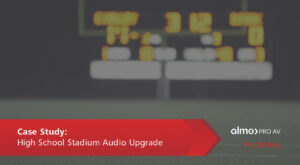One way or another, school is coming this fall. Tips for being prepared.
Written by Rob Voorhees, Business Development Manager, ALMO

We find ourselves smack in the middle of July when days are getting hotter and in years past, we might find ourselves looking forward to August vacations or days by the pool. However, 2020 has continuously thrown curveball after curveball, and we continue to adapt as best as we can. If your house is anything like mine, one of the biggest topics has been “what is happening when schools open in September?” Considering my wife is an elementary teacher and my daughters will be entering 7th and 4thgrades respectively, I multiply that same question by 3 every day. My home state of NJ is fortunate in that we have begun to reopen in phases, and it was recently announced that our schools could reopen although with a very large “IF” attached to it. School districts nationwide are being advised to space out desks, close cafeteria lunches, and ban recess time in order to protect our children, our teachers, and our communities as a whole. Some schools have already announced the continuation of remote schooling or even a hybrid model for the upcoming year. This is where the term “Distance Learning” really resonates with us all.
Distance Learning is not as simple as just recording a lesson and emailing it to your students. I certainly learned that earlier this year as I saw the hours that my wife was spending on lesson plans, zoom calls, and videos to help her students as best as possible. Not to mention the frustration she would have with managing the shrinking attention spans of children and ensuring her video calls did not crash on a daily basis. A close friend of mine, who is also a teacher, has told me “distance learning was challenging. I worked more hours than I did while in the classroom and nearly everything had to be created from scratch to best accommodate each of her students. The technology component was also a challenge because teachers were expected to learn each of these new platforms with little to no preparation or background.” As most can attest, one particular challenge in distance learning is the need to now rely on the internet and technology more than ever. Simply put, if you cannot access the internet, you cannot access the day’s lesson. Comcast, amongst other internet service providers, took the initiative early on and made affordable internet available to everyone while others managed their nationwide networks to prevent from congestion or outages. You then also need to ensure you have the proper tools to access the internet. Several districts across the country will supply students with Chromebooks each year, which is a great start. Internet Bandwidth Service remains an essential service and if schools are debating on hybrid schedules or full remote learning models, they will need to ensure the bandwidth is available for the lessons to be streamed each day. Hybrid models will mean every teacher has a smaller class during the day while simultaneously being recorded so their remote students at home can learn at the same time. Now imagine 20+ teachers all doing this at the same time and you can see where network congestion and outages will become a headache. It becomes important to team with an A/V integrator and solution partner like ALMO who can provide an analysis of the current bandwidth at the school and then make recommendations for improvements based on the number of employees and the number of devices. In several cases, this type of analysis could also lead to larger cost savings over an annual basis, which is one thing most school districts would love to see! “What about the students at home?” you might be asking. School districts can now supply mobile hotspots or tablets with built in access to students in need to ensure that everyone can access the same material. There is also a reporting and device management layer to this, which the schools would find essential. Administrators can have access to deactivate lost or stolen devices, escalate issues due to improper usage, or even identify cost saving measures by using the account analysis features. All of this becomes a necessity if we are truly looking to embrace a new norm for our children and educators. I think my closest friends and I are in agreement in that virtual schooling has become a necessity. While currently imperfect, there is definitely a bigger opportunity in September for improved engagement between teacher/student as well as some much needed social interaction between student/student.

In closing, I commend our school districts for navigating these difficult times and my hope is with the above suggestions and by partnering with the right integration firms and AV distributors they can alleviate some of the technological stress our students, teachers, and parents are facing and will face moving forward. To help, ALMO Pro AV will be hosting a special Distance Learning Preparedness webinar on July 31st at noon ET to share ideas and insights on pivotal technology equipment for a smoother and more effective hybrid learning environment when school is back in session. Lastly, let us all continue to stay safe and do our small part to make the learning experience easier this fall and beyond.







